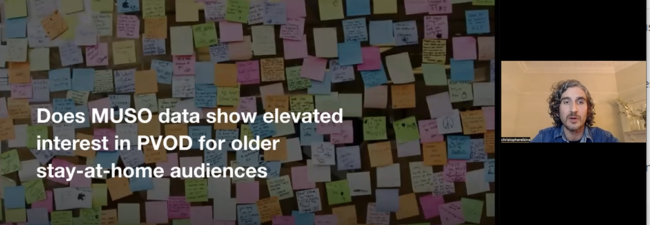
CPS 2022: Money’s Being Left on the Table Amid Battle Against Piracy
Although the media and entertainment (M&E) industry has found some success in fighting pirates stealing their content, a lot of distribution profits may be getting left on the table, according to Christopher Elkins, co-founder of MUSO, a London-based technology company that provides anti-piracy and market analytics solutions to disrupt the piracy market for digital content.
There had been a debate on “how we could run this conversation for probably 15 hours rather than 15 minutes,” he said at the Dec. 6 Content Protection Summit (CPS), during the session “Responding to Demand: How Much are we Leaving on the Table?”
The session was all about understanding and measuring the “demand” side fueling piracy, and what businesses are potentially leaving on the table as we remove the bad guys/pirate-supply without backfill from the businesses.
MUSO is a data company that measures unlicensed demand, he said, noting, “we pivoted out of content protection 5-6 years ago” but still maintains “that side of our business.”
The company developed a platform to identify data market issues amid what was a lack of accurate data with limited sources, he noted.
“As we brought that data into the market, we realized that the application wasn’t only on the revenue leakage side,” he told attendees. “We discovered that the opportunity was greater than that in the traditional kind of data space, where you have third-party and first-party data sets being used” to understand audience behavior and content performance internationally and regionally, he said.
 Over the last decade, “the audience has really shifted away from that demographic that we represented: being male skewed and perhaps focused on a certain genre of content, historically, to now being quite a broad, quite a demographically balanced audience from the surveys and the studies that we kind of collect as a meta study,” he said.
Over the last decade, “the audience has really shifted away from that demographic that we represented: being male skewed and perhaps focused on a certain genre of content, historically, to now being quite a broad, quite a demographically balanced audience from the surveys and the studies that we kind of collect as a meta study,” he said.
The “most valuable” data on who was viewing pirated content that he saw in the past 5-6 years had been by the University of Amsterdam, he said, noting it included a large sampling of 35,000 respondents, which “indicated that essentially consumption was focused around them being very high intent audiences but actually the highest consumers of content as well.”
He explained: “They were super consumers and I think the ways that they were consuming that content as well was fairly broad and fairly universal and fairly aligned to the ways that the legal audience, the pay audience consume content, which gave us confidence to use the data in this way and to approach those business teams outside of the content protection space to understand what they were using and if there was a need to have a third-party data set like this.”
MUSO “realized that there is a valuable side of this data which has really come to life and, I think the past couple of years as a business has really seen that most of our conversations now across film, across TV and live sports as well have “really been about emphasizing and education, educating those teams that there is value in the Paris audience.”
He noted “there is value in using this data for different use cases” and consumers were “visiting over 150,000 websites [and] over 10 billion pages of unlicensed content across streaming and downloading that we’re capturing each day.”
MUSO assigns “specific metadata by title and then we’re adding a taxonomy to that, so it starts with measuring the actual ecosystem by the number of piracy sites, and then it feeds into our ability to then categorize these sites by the type of site it is, and then obviously by the specific content,” he explained.
The company has “fine-tuned” its methodology and that’s “given us this interesting, I think, positioning that we found … going up against the party data sets that are quite traditional in orientation, our data is quite competitive,” he said. In fact, it’s outperformed some of those data sets, he added.
MUSO has been “able to give these rights owners and various different entities the ability to kind of see past the walled gardens that they have and understand from an international and global perspective and also from a content strategy, kind of future view perspective, crystal ball gazing what may be happening by looking at [the] piracy consumer, this super user, early adapting consumer base,” he said.
What’s more, “it’s a reliable data source as well,” he said, noting “we worked with our partners, studios, broadcasters, streamers, and economic kind of government agencies who are our backbone,” he said.
Thus “gives the ability to use this data and position this data as well as a reliable data source to be able to use it for business critical kind of situations, and that’s all done through a dashboard,” he noted.
MUSO now has “over 350,000 titles now in the data set across film and TV,” he said, adding “it’s across a large body of sites, essentially mapped against mostly streaming sites and then the P2P kind of direct downloads as well, which we measure in different ways,” he pointed out.
The P2P side “we measure obviously directly via IP and then the streaming side, we measure by third-party providers where we’ve built up a great arsenal of partners,” including web measurement platforms, he said.
“So we’ve got this really great bunch of customers that are using the data right across the media kind of ecosphere,” he went on to say, adding the “use cases are really varied and really broad, right from the content protection side and revenue leakage through the value chain, right up to, I’d say, the content strategy side.”
He went on to show attendees two use cases.
Presented by Fortinet and produced by MESA, CDSA’s Content Protection Summit is sponsored by Convergent Risks, Richey May Technology Solutions, GeoComply, Signiant, Verimatrix, Shift Media, EIDR and EZDRM.
